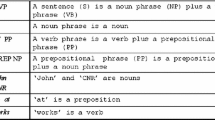Abstract
As described in this paper, we investigated the effect of the symmetry bias on linguistic evolution. We specifically examined symmetry bias, which indicates the meaning in a state of environment. For this task, we constructed a meaning selection iterated learning model based on Simon Kirby’s iterated learning Model, and used it for simulation with three strategies: perfect matching symmetry bias, imperfect matching symmetry bias, and random strategy. Results of applying imperfect matching symmetry bias show that the language of the agent evolved into more compositional language. The agent acquired a more expressive, and a more similar language to the parent’s language than with the Random strategy agent. However, application of perfect matching symmetry bias showed that the language of the agent did not evolve. The agent acquired a less expressive and a more different language to the parent’s language than with Random strategy agent. Our experimentally obtained results demonstrate that the effect of imperfect matching symmetry bias accelerates linguistic evolution into compositional language, whereas perfect matching symmetry bias disturbs linguistic evolution.












Similar content being viewed by others
Explore related subjects
Discover the latest articles, news and stories from top researchers in related subjects.Notes
Chunk and merge is what Kirby defined, but, replace is defined by Hashimoto as an independent operation from Kirby’s research[13].
References
Imai M, Haryu E (2004) The nature of word learning biases: from a cross linguistic perspective. In: Hall DG, Waxman SR (eds) Weaving a lexicon. MIT Press, pp 411–444
Landau B, Smith L, Jones SS (1988) The importance of shape in early lexical learning. Cogn Dev 3:299–321
Matoba R, Sudo H, Hagiwara S, Tojo S (2013) Evaluation of efficiency of the symmetry bias in grammar acquisition. Proceedings of the 18th International Symposium on Artificial Life and Robotics (AROB2013), pp 444–447
Matoba R, Nakamura M, Tojo S (2011) Efficiency of the symmetry bias in grammar acquisition. Inf Comput 209:536–547
Imai M, Gentner D (1994) Children’s theory of word meanings: the role of shape similarity in early acquisition. Cogn Dev 9(1):45–75
Imai M, Gentner D (1997) A crosslinguistic story of early word meaning: universal ontology and linguistic influence. Cognition 62(2):169–200
Hattori M (2013) Adaptive heuristics of covariation detection: a model of causal induction. Proceedings of the Fourth International Conference on Cognitive Science and the Seventh Australasian Society for Cognitive Science Joint Conference (ICCS/ASCS 2003), Vol. 1, pp 163–168
Sidman M, Rauzin R, Lazar R, Cunningham S, Tailby W, Carrigan P (1982) A search for symmetry in the conditional discriminations of rhesus monkeys, baboons, and children. J Exp Anal Behav 37(1):23–44
Hurford JR (1989) Biological evolution of the Saussurean sign as a component of the language acquisition device. Lingua 77(2):187–222
Oliphant M (1996) The dilemma of Saussurean communication. Biosystems 37(1–2):31–38
Kirby S (2002) Learning, bottlenecks and the evolution of recursive syntax. In: Briscoe T (ed) Linguistic evolution through language acquisition. Cambridge University Press
Cann R (1993) Formal semantics: an introduction. Cambridge University Press, New York
Hashimoto T, Nakatsuka M (2006) Reconsidering Kirby’s compositionality model toward modelling grammaticalisation. The evolution of language: Proceedings of the Sixth International Conference(EVOLANG6), World Scientific, pp 415–416
Acknowledgments
This work was partly supported by a Grant-in-aid for Scientific Research (C)(KAKENHI) No. 25370681 and a Grant-in-Aid for Young Scientists (B)(KAKENHI) No. 15K16013.
Author information
Authors and Affiliations
Corresponding author
Additional information
This work was presented in part at the 20th International Symposium on Artificial Life and Robotics, Oita, Japan, January 21–23, 2015.
About this article
Cite this article
Sudo, H., Matoba, R., Cooper, T. et al. Effect of symmetry bias on linguistic evolution. Artif Life Robotics 21, 207–214 (2016). https://doi.org/10.1007/s10015-016-0276-7
Received:
Accepted:
Published:
Issue Date:
DOI: https://doi.org/10.1007/s10015-016-0276-7




